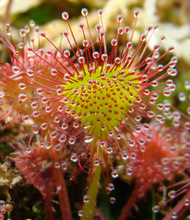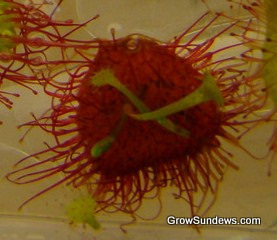Drosera rotundifolia 'Charles Darwin'Drosera rotundifolia ‘Charles Darwin’ is a hybrid created by Ivan Snyder. He crossed aform of D. rotundifolia with a weak dormancy requirement from Gasquet, Del Norte, Co. in California that has a weak dormancy requirement compared to most D. rotundifolia, with a larger form of D. rotundifolia from Willow Lake, N. Plumas Co. California (reference). The result is a large (stunning) D. rotundifolia that has a weak dormancy requirement. Unlike most other forms of D. rotundifolia, the 'Charles Darwin' form often flowers before going into dormancy and produces seed that does not require cold stratification. See the link to the right for more information about this cultivar. |
|
| Drosera rotundifolia 'Charles Darwin'
 Drosera
rotundifolia 'Charles
Darwin' leaf
Drosera
rotundifolia 'Charles
Darwin' leaf D. rotundifolia 'Charles
Darwin' leaf
cutting after 2 weeks floating on water
D. rotundifolia 'Charles
Darwin' leaf
cutting after 2 weeks floating on water |
Media: The beautiful plant in the top-left picture was grown in 100% Living Sphagnum. It is best to mix in a little peat moss and sand (silica) to keep the live sphagnum healthy. Alternatively, a peat and sand mixture or dead long-fibered sphagnum can be used. Media moisture: keep saturated or waterlogged for best results. Humidity: above 50-60% is probably recommended. The tray method usually provides this humidity level for me during the winter months inside my home. Pot height: can be easily grown in pots 3-inches or shorter. Trapping speed: is suprisingly fast. If prey is moving around, tentacle movement is very noticeable. Feeding: VITAL to growth. See feeding page. Food size: medium to small to avoid burning. Plant dimensions: can get rather large- I'll get actual dimensions in the near future. Temperature: Give subropical to tropical conditions. My temperate plants go dormant at 60 degrees F with no photoperiod change (16 hours a day, year-round) so keep above this range to ensure that active growth continues. I have not yet tested the actual range of this plant. This is only a rough guideline. This species can handle temperatures in the lower-mid 90 F range if healthy and has sufficient humidity. Also, if temps are too warm, this sundew may die back to the roots. So keep in the recommended range to be safe. Lighting/Photoperiod: Give as much light as possible. Tentacles will become bright red in sufficient light. Will flower on a 16 hour photoperiod. Dormancy requirements: If grown in temperate conditions, and treated as a typical D. rotundifolia, this cultivar will form a dormant bud, like normal. This form can be grown for a year or more without going into dormancy, if conditions are favorable. However, I had several plants (both young and old) die off on me spontaneously. It didn't matter whether they were fed or not- at the same time of the year (after the 70F temps inside my house during the spring reached 80 F) they all just randomly decreased in size at the same time and turned brown. Oddly, the D. x nagamatoi in the same pot as one of the now deceased D. 'Charles Darwin' has grown well to this day (2 years later)... Luckily, I had taken many leaf cuttings and given away/traded several plants before this happened. One small plantlet also survived form me, which I'm currently nursing to adulthood... I don't want to discourage people from growing this beautiful plant. It is an amazing one---just don't be suprised if something random like this happens to you, and be sure to take as many leaf cuttings as possible, as backups. Flowers: will form after around 7 months, or less from seed, if fed often. This plant is self-fertile. Seeds may start sprouting in the seed pod after they ripen, so keep the pod dry for trades. I have had issues collecting viable seed, since the flower stalks reach too close to the lights I grow them under, which is too warm for them. Propagation TechniquesSeed: easy. Cold stratification is not required. However, I am yet to try this for myself. Leaf-cuttings: work extremely well. One of the top three easiest/ fastest sundews to propagate. Will form a plantlet in the center of the leaf. Make sure to feed the plantlets after they sprout in order to rapidly speed up growth. Flower stalk cuttings will likely not work, but I'm yet to try this. Root cuttings: should work, but I’ve never tried. Leaf cuttings are likely the best-bet. Divisions: will clump over time. Should not be too picky as long as you don’t rip apart to many roots in the process. |
Additional Questions or Suggestions?
Contact me at: sundewman(at)yahoo.com